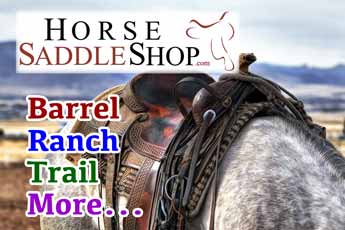Cowboy Dictionary
Welcome to our cowboy dictionary! We have definitions for words and lingo common to a cowboy or horse-loving lifestyle. Many definitions are illustrated with photos.
While some cowboy dictionaries focus mainly on old-time or Old West definitions, our dictionary is a bit different: We focus mainly on words, terms, and slang frequently in use among the working cowboys and cowgirls of today.
Letters A-B
Antlers - Antlers are bony protrusions found on the skulls of animals in the family Cervidae. Commonly called the "deer family," Cervidae include animals such as deer, elk, moose, and reindeer.
With one exception antlers are grown only by the males of the species. The exception is in reindeer, where both males and females grow antlers.
Antlers are not a permanent part of the animals' skull but instead are grown, shed, and re-grown annually.
Below: A bull elk with antlers.
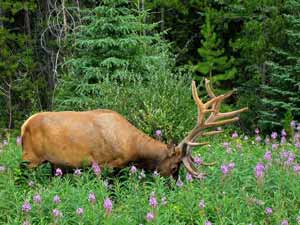
Antlers, both real and faux, are often made into chandeliers. This includes moose antlers.
Around The Horns - In team roping and some other competitive roping events, "around the horns" is one of three legal head catches. "Around the horns" is sometimes also called a "horn catch" or "a clean horn catch."
An around the horns catch is pictured below. Notice that the loop goes underneath both horns.
Below: An around the horns catch, one of three legal head catches in team roping and some other competitive roping events.
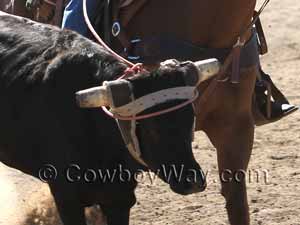
We also have a complete page about the three legal head catches in team roping.
The steer in the above photo is wearing a protective horn wrap. Horn wraps are necessary to protect the steer's head, as well as the horns themselves.
Bangs - A casual or slang term for the disease Brucellosis in cattle. The terms "banger" and "banged out" are used to describe cattle that have tested positive for Brucellosis.
Barrel Racing - A competitive event in which a horse and rider run a cloverleaf pattern around three 55-gallon barrels. It is a timed event in which the fastest time wins. Though most recognized as a sport competed in by women, depending on what (if any) governing body sanctions a barrel race the rider might be male or female.
You can shop for barrel racing saddles here.
Barrel Racing Pattern - This definition of the cloverleaf barrel racing pattern has its own page.
Barrier - In rodeo, a barrier is a device used in the roping and steer wrestling events to allow the calf or steer a head start.
The barrier has two parts. One part goes around the neck of the calf or steer, and the other part is a rope stretched across the front of the roping box. When the calf or steer runs into the arena and reaches the end of their pre-determined head start (called the "score"), the part of the barrier around their neck triggers the release of the barrier rope in front of the roping box, allowing the roper or steer wrestler to begin pursuit.
Almost simultaneously, the part of the barrier around the neck of the calf or steer breaks away so they can continue down the arena.
However, if the roper or steer wrestler begins pursuit too early, they will run into the rope across the front of the roping box. This rope is actually two separate pieces that are tied together with string, and when it's run in to the string breaks. This is called "breaking the barrier" and the roper or steer wrestler is given a time penalty (usually 10 seconds).
Below: The yellow highlights illustrate the part of the barrier around the neck of the steer, and the part that stretches across the front of the roping box.
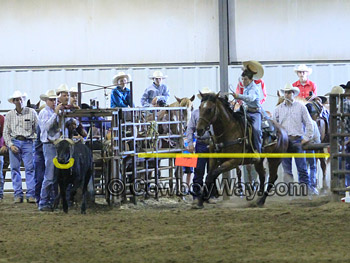
Batwing Chaps - Batwing chaps, or "batwings," are a type of leather leg covering worn by cowboys and cowgirls for protection against weather, trees, brush, kicks, rope burns, and other hazards. For a picture of batwing chaps please see our page Cowboy Dictionary - Letter C and look for the definition of "chaps."
You can shop for batwing chaps here.
Advertisement - Article continues below.
Black White Face - A way of describing cattle by color, referring to a cow (or bull, steer, or heifer) with a (mostly) black body and a (mostly) white face. In writing, black white face is often abbreviated as BWF.
Below: A black white face (or BWF) cow.

Blood Mark or Bloody Shoulder Mark - A blood mark, also called a bloody shoulder mark, is a marking found only on flea bitten gray horses. The blood mark is not gray like the rest of the horse but is instead some other color.
Commonly, blood marks are red (chestnut) which gives the marking its name. We have a lot more information about blood marks here.
Below: A blood mark on the side and belly of a gray horse. They are also called bloody shoulder marks regardless of where they are located.
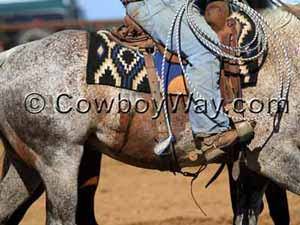
BLM Brand - A brand registered to the Bureau of Land Management (BLM), an agency of the United States Department of the Interior.
A BLM brand is perhaps best known as the brand found on some feral horses (aka "mustangs") in the United States. The BLM applies their brand to the left side of the horse's neck. The brand begins with a special character to indicate the brand is registered with the BLM.
After that, there is a series of the same character, turned at different angles, with each angle representing a different number.
We have a page explaining a BLM brand in greater detail.
Below: A BLM brand on a horse.
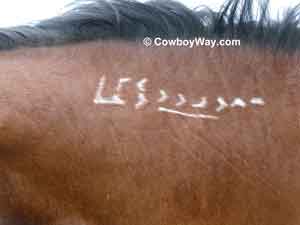
You might also like: Pictures of mustang horses.
Bolt - When referring to horses, to bolt means a horse that suddenly and unexpectedly runs as fast as it can. If a horse bolts in the pasture it might be part of routine play. However, a horse that bolts under saddle has a dangerous vice.
Bosal - The definition of a bosal has its own page.
Brand - The definition of a brand has its own page.
Branding Iron - The tool used to make a brand on the hide of an animal.
Bred Cow - A cow that is currently bred, or pregnant.
Bridle - A piece of equipment put on a horse's head to communicate with it while it is being ridden. A bridle is made up of two basic parts: 1) a headstall, and 2) a bit (or related piece of equipment).
The headstall's primary job is to hold the bit in place, but the headstall can also impart a "feel" and communicate to the horse from the rider. The bit, nose piece, or other piece of equipment that makes up a bridle is also a communication piece, and is connected from the headstall to the rider's hands through an additional piece of equipment called "reins."
While a headstall and a bit are collectively known as a bridle, headstalls and bits are almost always sold separately. There is a wide variety of both headstalls and bits, and each piece is purchased separately to meet the specific needs and preferences of different horses and riders.
Below: A bridle.
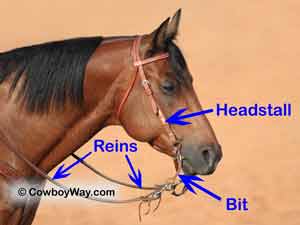
Brock Face - A facial marking in cattle where the face has a base color of white, but also has areas (similar to spots) of colored hair (such as black or red). Also called "brockle face," "mock face," and/or "mockle" face.
A brock face can be further described according to the color of the animal's body. For example, a black cow (or bull, steer, etc.) with a brock face can be called a "black brock face" (BBF), while a red cow with a brock face would be called a "red brock face" (RBF).
Below: In front are two black brock face (BBF) heifers.
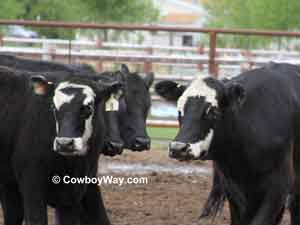
Broke Horse - A horse that has been trained to be ridden. A horse might be further described as "green broke" (the horse's training is not yet complete) or "kid broke" (considered to be gentle and safe for inexperienced riders).
Bronc - A horse that volunteers to buck well and consistently. A bronc might be a member of a rodeo bucking string, or a saddle horse that is known to buck hard and regularly.
Horses that buck the first couple of times they are ridden, or horses that have not yet been trained to be ridden, are not properly referred to as broncs.
"Bronco" means the same things as "bronc."
Bucking Rolls - Bucking rolls are a piece of equipment sometimes added to the front of a saddle to help a rider stay secure during bucking or other rough riding.
Bucking rolls are most commonly found on "slick fork" styles of saddles. The fork (also known as the "swells") is the area of the saddle to the left and right of the saddle horn.
While having a saddle with a slick fork (or low swells) has certain advantages in some situations, it can also sometimes allow for too much movement for the rider during bucking or other rough riding.
Bucking rolls add swells to a saddle, taking up some of the open space to help a rider remain secure in tricky situations. Bucking rolls are easily attached and removed, allowing a rider to modify their saddle when the need arises.
You can shop for bucking rolls here.
Below: Bucking rolls.
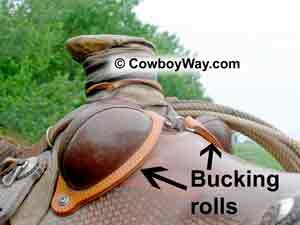
Bull - An un-castrated male animal belonging to the genus Bos, which includes the species cattle.
Definitions
… Letter C
… Letter S
… Letter T
You Might Also Like
